RANKING OF COUNTRIES BY INTERNET USAGE CRITERIA WITH DEMATEL BASED ANP (DANP) AND WASPAS METHODS
DOI:
https://doi.org/10.37242/pejoss.3237Keywords:
DEMATEL Based ANP (DANP), WASPAS, Multi-Criteria Decision Making Methods, Internet Usage, Country RankingAbstract
The objective of this study is to rank countries according to internet usage criteria. In this context, the first 40 countries at different development levels prepared by IMF constitute the study’s sample. However, since data onall criteria for ten countries could not be obtained, 30 countries were included in the analysis. The ranking of the countries was formed with the data obtained for both 2018 and 2022. Thus, it has been evaluated whether there has been a critical change in the rankings of countries regarding internet usage from 2018 to 2022. The obtained data were analyzed by using DANP and WASPAS MCDM methods. The criteria weights were calculated with the DANP method, and the countries were ranked with the WASPAS method. According to the results of the DANP method, while mobile internet usage time has the highest criterion weight, the internet adaptation rate has the most negligible criterion weight. To the results of the WASPAS method, Singapore, United Arab Emirates, Sweden, South Korea, and the Netherlands are in the top five. The Philippines, Vietnam, China, Indonesia, and Egypt were in the last five in the internet usage ranking in 2018. Besides that, United Arab Emirates, Saudi Arabia, Singapore, Canada, and South Korea are in the top five, while Italy, Mexico, Vietnam, Indonesia, and Egypt are in the last five in 2022. In the comparison made as a result of the analysis, there is no significant change in the ranking of internet usage between 2018 and 2022, except for a few countries. Saudi Arabia, Malaysia, Ireland, and Brazil ranked higher in 2022 compared to 2018, while Sweden, Netherlands, Belgium, Germany, and Japan fell in the rankings compared to 2018.
Downloads
Downloads
Published
How to Cite
Issue
Section
License
Copyright (c) 2022 Premium e-Journal of Social Science (PEJOSS)

This work is licensed under a Creative Commons Attribution 4.0 International License.


